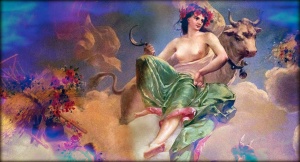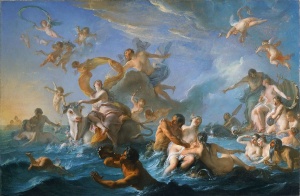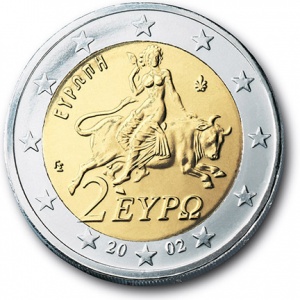Difference between revisions of "Language/Modern-greek-1453/Culture/The-Rapture-of-Europe"
m (Quick edit) |
|||
| (3 intermediate revisions by 2 users not shown) | |||
| Line 2: | Line 2: | ||
[[File:ob_5e9624_plafond-petit-theatre.jpg|thumb]] | [[File:ob_5e9624_plafond-petit-theatre.jpg|thumb]] | ||
The | The myth of the Rapture of Europe is a timeless one, impressed upon the European and Mediterranean regions in many forms - in mosaics, ancient vases, coins, doors, classical paintings, modern features, sculptures and more. It holds special meaning as it symbolizes the mythological roots of Europe and its relation to Greek culture, as well as the creative adventure of the unification of Europe. | ||
According to the myth, Zeus, enchanted by the beauty of Europa, daughter of Agenor, king of Phoenicia, transformed into a pale and beautiful bull and approached her calmly, while his breath smelled of roses. With horns like a crescent, he lay at the girl's feet. His gentleness fooled Europe and her fear was replaced by a desire to sit on his back. Quick as lightning, the bull rose and rushed into the sea, and Europe could not descend, and no one intervened. | |||
The couple accompanied a procession of dolphins, Nereids, Tritons, and Poseidon to Crete. Hooked on the horns, Europe descended from the back of the animal to Gortyna, the city of the island of Crete, where the Hores prepared the bridal bed in the Diktaeon antron, the birthplace of Zeus. From their union, Minos, Rhodamanthys, and Sarpedon were born. | |||
The myth of the Rapture of Europe expresses the common heritage of Europeans: a free and restless spirit, mobility and emotions, and a meeting of cultures. It has preoccupied researchers of anthropology and semiotics, while inspiring artists with its rich expression and interpretation that perfectly embodies the multiculturalism of Europeans and the common foundations of their culture. | |||
This myth is depicted on the Greek 2 euro coin with the rapture of Europe by Taurus-Jupiter. | |||
[[File:Noël-Nicolas_Coypel_Europe.jpg|thumb]] | [[File:Noël-Nicolas_Coypel_Europe.jpg|thumb]] | ||
[[File:griechenland_2euro.jpg|thumb]] | [[File:griechenland_2euro.jpg|thumb]] | ||
==Other Lessons== | |||
* [[Language/Modern-greek-1453/Culture/Sapphô|Sapphô]] | |||
* [[Language/Modern-greek-1453/Culture/Cyprus-Timeline|Cyprus Timeline]] | |||
* [[Language/Modern-greek-1453/Culture/Greek-Salad-Horiatiki-Salata|Greek Salad Horiatiki Salata]] | |||
* [[Language/Modern-greek-1453/Culture/Greek-Proverbs|Greek Proverbs]] | |||
* [[Language/Modern-greek-1453/Culture/Best-Greek-Street-Food|Best Greek Street Food]] | |||
* [[Language/Modern-greek-1453/Culture/Mediterranean-diet|Mediterranean diet]] | |||
* [[Language/Modern-greek-1453/Culture/March-8,-Women's-Day|March 8, Women's Day]] | |||
* [[Language/Modern-greek-1453/Culture/épopée-Homérique-Odyssée|épopée Homérique Odyssée]] | |||
* [[Language/Modern-greek-1453/Culture/The-mysterious-origins-of-punctuation|The mysterious origins of punctuation]] | |||
* [[Language/Modern-greek-1453/Culture/Figures-of-Speech-Definitions-and-Examples|Figures of Speech Definitions and Examples]] | |||
<span links></span> | |||
Latest revision as of 22:04, 26 March 2023
The myth of the Rapture of Europe is a timeless one, impressed upon the European and Mediterranean regions in many forms - in mosaics, ancient vases, coins, doors, classical paintings, modern features, sculptures and more. It holds special meaning as it symbolizes the mythological roots of Europe and its relation to Greek culture, as well as the creative adventure of the unification of Europe.
According to the myth, Zeus, enchanted by the beauty of Europa, daughter of Agenor, king of Phoenicia, transformed into a pale and beautiful bull and approached her calmly, while his breath smelled of roses. With horns like a crescent, he lay at the girl's feet. His gentleness fooled Europe and her fear was replaced by a desire to sit on his back. Quick as lightning, the bull rose and rushed into the sea, and Europe could not descend, and no one intervened.
The couple accompanied a procession of dolphins, Nereids, Tritons, and Poseidon to Crete. Hooked on the horns, Europe descended from the back of the animal to Gortyna, the city of the island of Crete, where the Hores prepared the bridal bed in the Diktaeon antron, the birthplace of Zeus. From their union, Minos, Rhodamanthys, and Sarpedon were born.
The myth of the Rapture of Europe expresses the common heritage of Europeans: a free and restless spirit, mobility and emotions, and a meeting of cultures. It has preoccupied researchers of anthropology and semiotics, while inspiring artists with its rich expression and interpretation that perfectly embodies the multiculturalism of Europeans and the common foundations of their culture.
This myth is depicted on the Greek 2 euro coin with the rapture of Europe by Taurus-Jupiter.
Other Lessons[edit | edit source]
- Sapphô
- Cyprus Timeline
- Greek Salad Horiatiki Salata
- Greek Proverbs
- Best Greek Street Food
- Mediterranean diet
- March 8, Women's Day
- épopée Homérique Odyssée
- The mysterious origins of punctuation
- Figures of Speech Definitions and Examples


